Transforming a steep hillside into a beautiful garden is easier than you think.
In this guide, you’ll find amazing and creative Landscaping Ideas for Steep Hillsides that use terracing, retaining walls, and smart planting to maximize your space. These practical tips work for both DIYers and pros.
Start exploring to turn your challenging slope into a stunning outdoor retreat.
Native Plant Selection
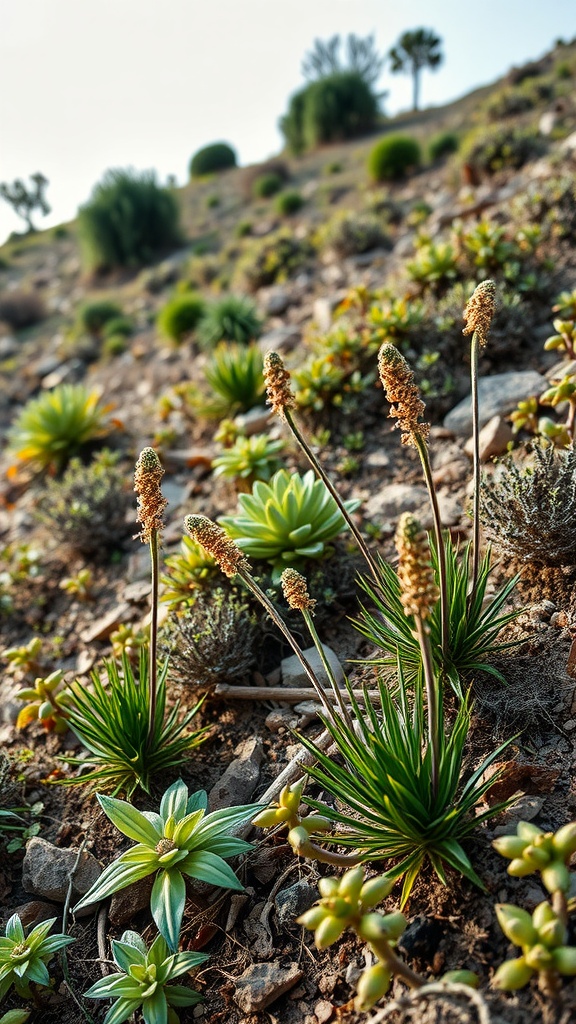
When thinking about landscaping a steep hillside, choosing native plants is a smart move. Native plants thrive in local conditions and support local wildlife.
The image shows a variety of native plants on a hillside, showcasing their beauty and resilience. These plants are well-adapted to the local climate and soil, making them easier to maintain.
Opting for native flora helps prevent erosion, which is a common issue on steep slopes. Their root systems are typically deeper, anchoring the soil more effectively. Plus, they require less water and fertilization over time.
Incorporating a mix of textures and colors can create a stunning visual display. Look for plants that bloom at different times throughout the year to keep the area lively.
Expert Tip: When selecting plants, make sure to consider their growth habits. Some may spread rapidly while others stay compact. This will help you maintain balance on your hillside.
Rock Retaining Walls
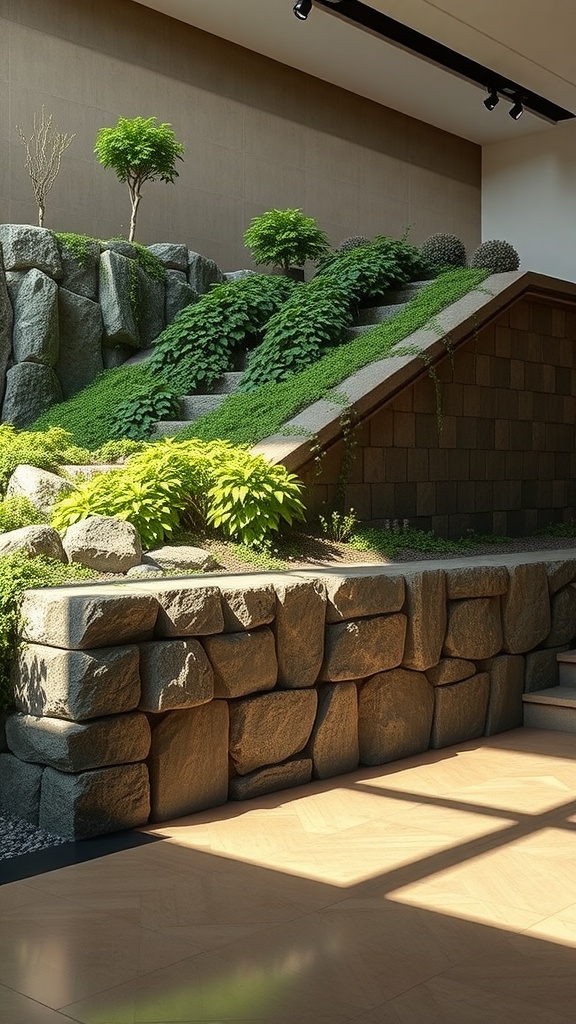
Rock retaining walls are a fantastic choice for steep hillside landscaping. They not only provide support but also enhance the overall look of your yard.
The image shows a beautifully crafted rock wall that blends naturally with the surrounding greenery. The stones are arranged in a way that creates a sturdy barrier while adding a rustic charm. The lush plants cascading down the slope add a vibrant touch to the scene.
Using natural stones can create a seamless transition between different levels of your yard. This approach not only prevents soil erosion but also introduces texture and visual interest.
Expert Tip: When building a rock retaining wall, ensure proper drainage to avoid water buildup, which can weaken the structure.
Pathway Navigation
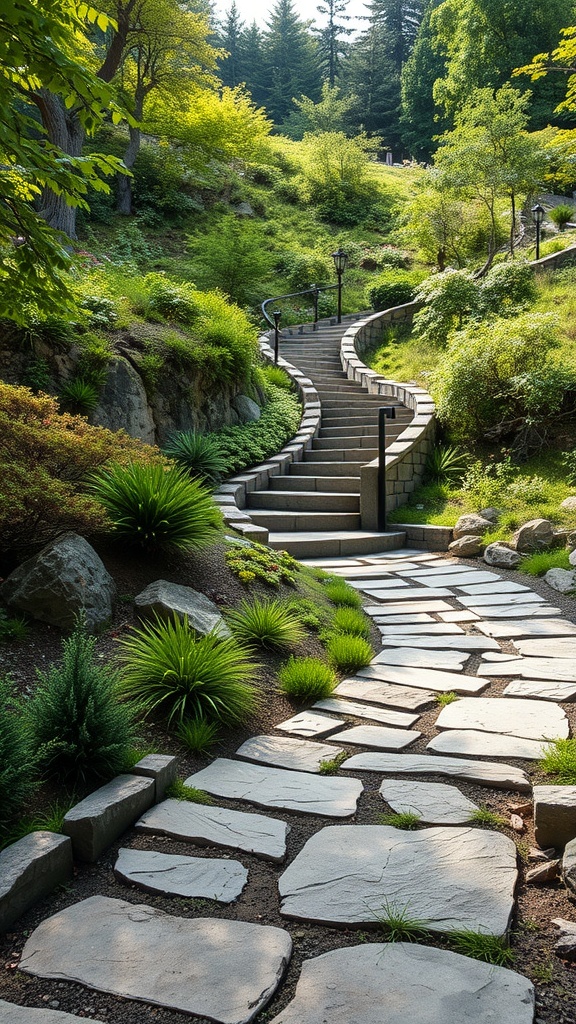
Navigating steep hillsides can be a challenge, but the right pathways make it easier and more enjoyable. The image shows a beautifully designed pathway made of stone, winding gracefully up a hillside. This layout not only creates a sense of flow but also provides a practical solution to navigating inclines.
Using natural materials like stone for the path adds texture and blends seamlessly with the lush greenery surrounding it. The gentle curves keep the journey interesting, inviting visitors to explore every nook and cranny of the landscape.
Adding elements like steps along the way gives a sense of direction and encourages safe movement on steep terrain. The strategically placed plants along the pathway soften the look and offer natural beauty.
Expert Tip: Consider installing lighting along the path for safe navigation during the evenings. It enhances safety and creates a warm atmosphere as the sun sets.
Terraced Garden Design
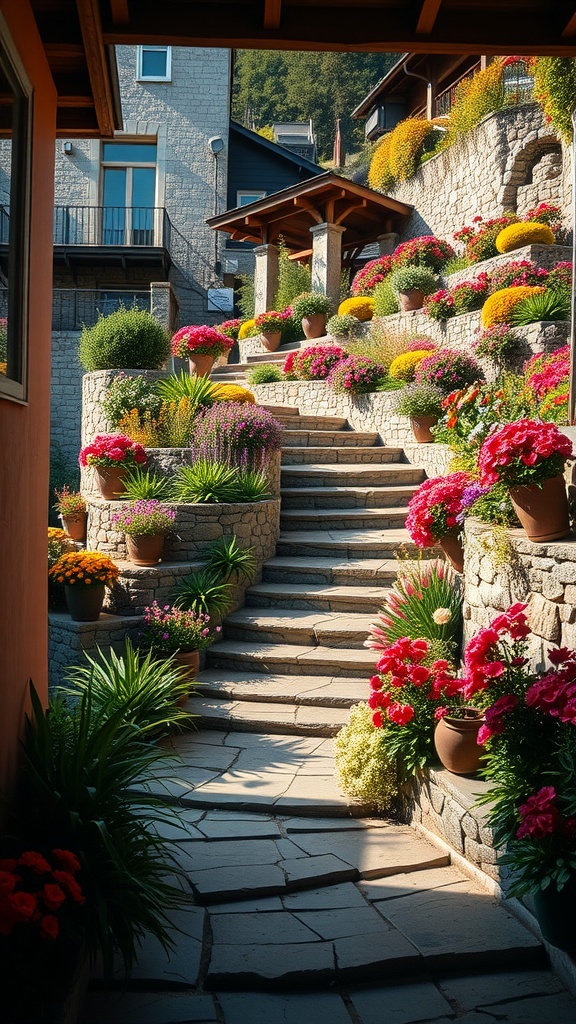
Terraced gardens are a fantastic way to manage a steep hillside. This method allows you to create a beautiful and functional landscape while preventing soil erosion. The image showcases a lovely terraced garden with vibrant flowers and neatly arranged stone steps.
The steps lead you through layers of colorful plants, making the garden feel inviting. Each terrace can be planted with different flowers or shrubs, adding variety and interest. Using potted plants, like those seen in the image, can add even more color and make maintenance easier.
Consider incorporating native plants that thrive in your climate. They will not only enhance the beauty of your garden but also support local wildlife.
Expert Tip: Use boulders or stones to create natural barriers between the terraces. This adds visual appeal and helps with drainage.
Terraced designs can also include seating areas. Adding a bench or chairs provides a spot to relax and enjoy the view. Placing lighting along the paths can make the garden accessible in the evening.
Water Feature Integration
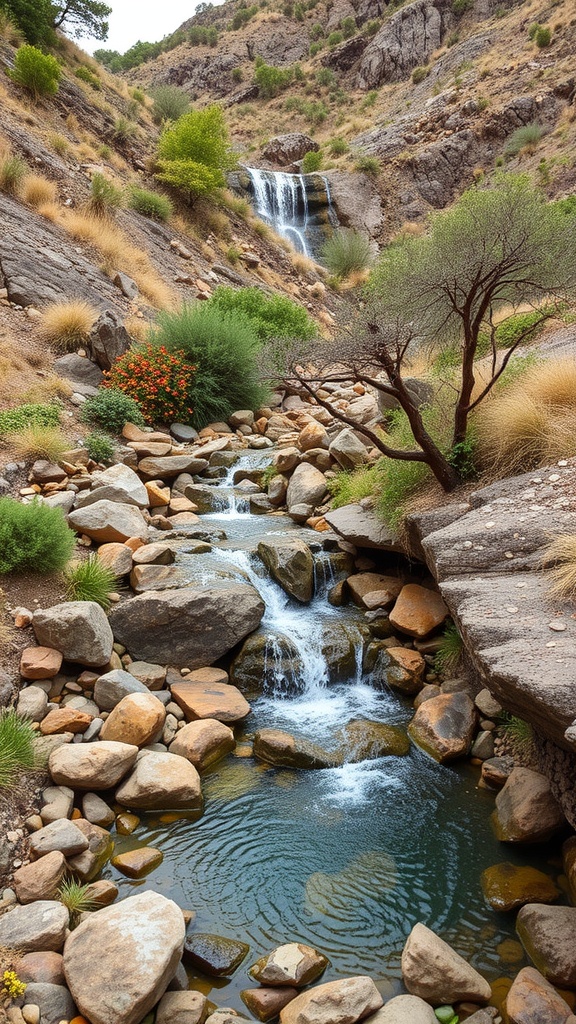
Integrating a water feature into a steep hillside landscape can create a stunning focal point. In the image, we see a beautiful series of waterfalls cascading into a serene pool, surrounded by rugged rocks and greenery. This natural design can enhance your outdoor space by adding both visual appeal and soothing sounds.
Consider using natural stone for the water feature, blending it seamlessly with the hillside. The gentle flow of water can create a calming atmosphere, perfect for relaxation. You might also think about incorporating plants around the water to provide a lush backdrop.
Expert Tip: Make sure to plan for proper drainage and water circulation to keep your features healthy and clean. This will ensure that your water feature remains a vibrant addition to your hillside landscaping.
Slope Stabilization Techniques
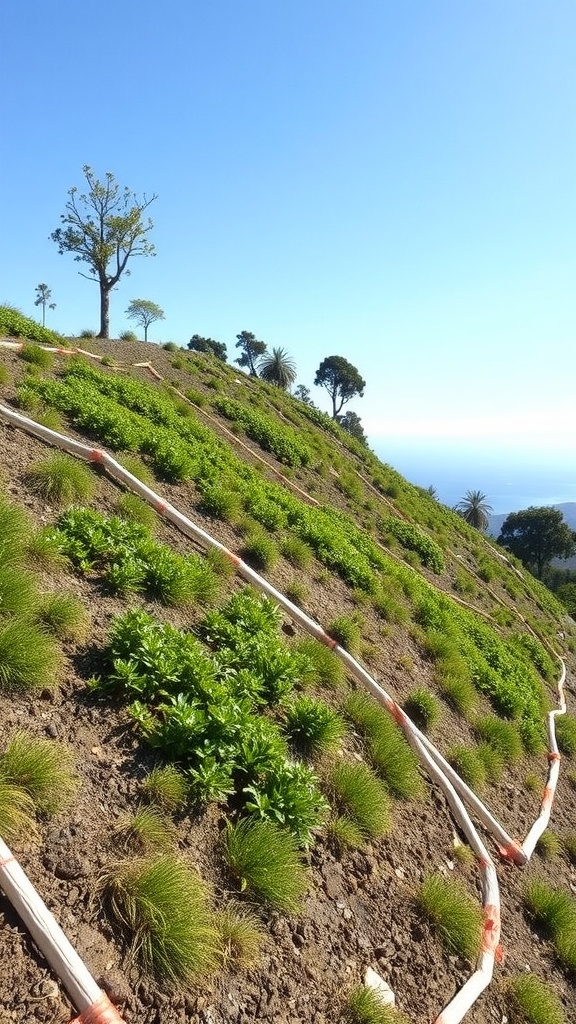
In landscaping, stabilizing a slope is key to preventing erosion and creating a beautiful outdoor space. The image captures a well-designed hill that showcases several effective slope stabilization techniques.
The layering of materials is essential. The sandy base serves as a solid foundation, while the white fabric helps retain soil. This combination minimizes washout during heavy rains. Adding native plants not only enhances the look but also promotes soil health. These plants have deep root systems that hold the soil in place.
Utilizing rocks and boulders can provide visual interest and additional stability. They act as natural barriers, breaking up the flow of water and reducing erosion. It’s a practical and aesthetic choice.
Another trick is to create terraced areas. This method levels out the slope, reducing the steepness, which lessens the risk of erosion. Terraces can also serve as planting beds, maximizing usable space.
Remember, maintenance is vital. Regularly check for any signs of erosion or plant health. This will ensure that your landscaping remains beautiful and functional over time.
Boulders as Focal Points
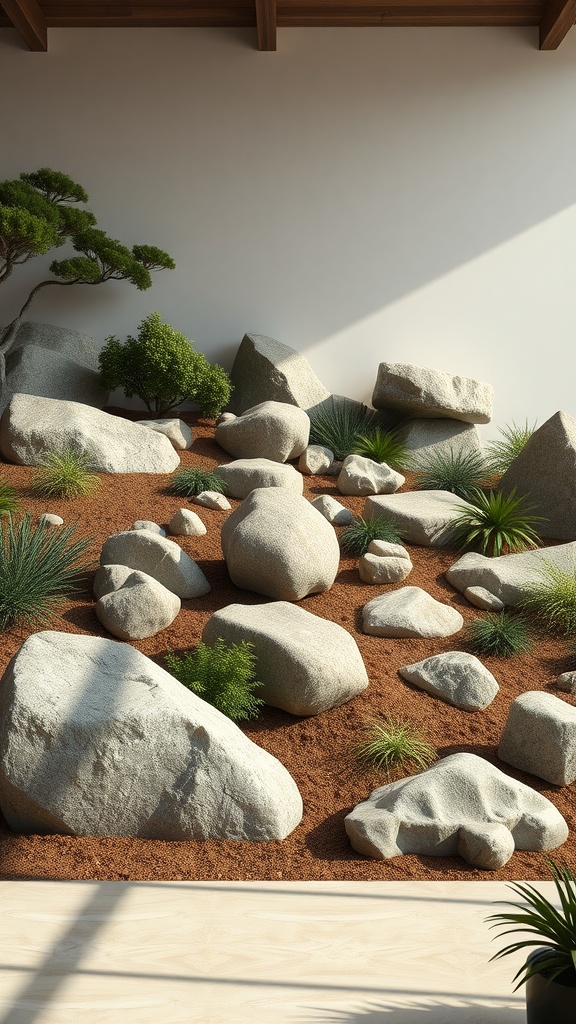
Boulders can transform a steep hillside into a stunning visual masterpiece. They act as natural focal points that draw the eye and add texture to your landscape.
In the image, you can see a variety of boulders interspersed with smaller plants and ground cover. This arrangement creates a beautiful contrast, enhancing the overall design. Each rock varies in shape and size, which adds interest and depth.
Incorporating boulders into your hillside landscaping offers not just beauty, but stability. They can help prevent soil erosion by anchoring the ground. Plus, they provide a habitat for wildlife, making your garden a lively ecosystem.
Expert Tip: Choose boulders that complement the natural color palette of your area. This integration will make the landscape feel cohesive and inviting.
Edible Landscaping
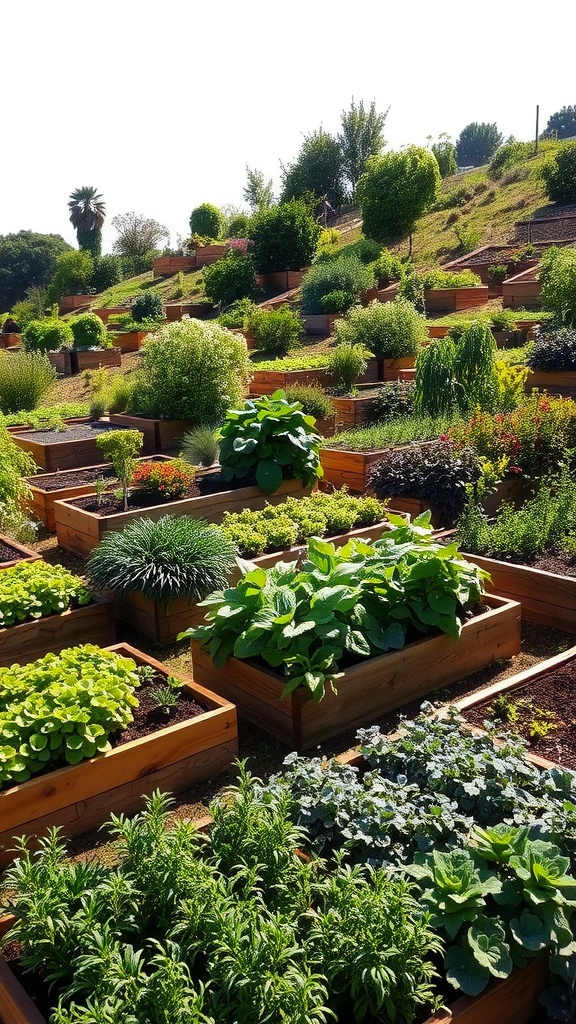
Steep hillsides can be a fantastic canvas for edible landscaping. Picture a vibrant scene filled with raised garden beds, overflowing with fresh herbs, vegetables, and greenery. This image showcases a hillside transformed into a flourishing garden, proving that even challenging terrains can produce delicious results.
Each raised bed not only adds depth to the landscape but also makes it easier to manage the soil and plants. Imagine picking your own tomatoes or basil right from your yard! Herbs like rosemary and thyme thrive in such setups, offering both beauty and utility.
Expert Tip: To maximize space, consider planting vertically. Using trellises for climbing plants like cucumbers or beans can save room while adding visual interest.
Mixing edible plants with ornamental ones can create a stunning display. Flowers like nasturtiums are not just pretty; they are also edible and bring a pop of color. With a little creativity, your hillside can be both a feast for the eyes and the palate.
Wildflower Meadow
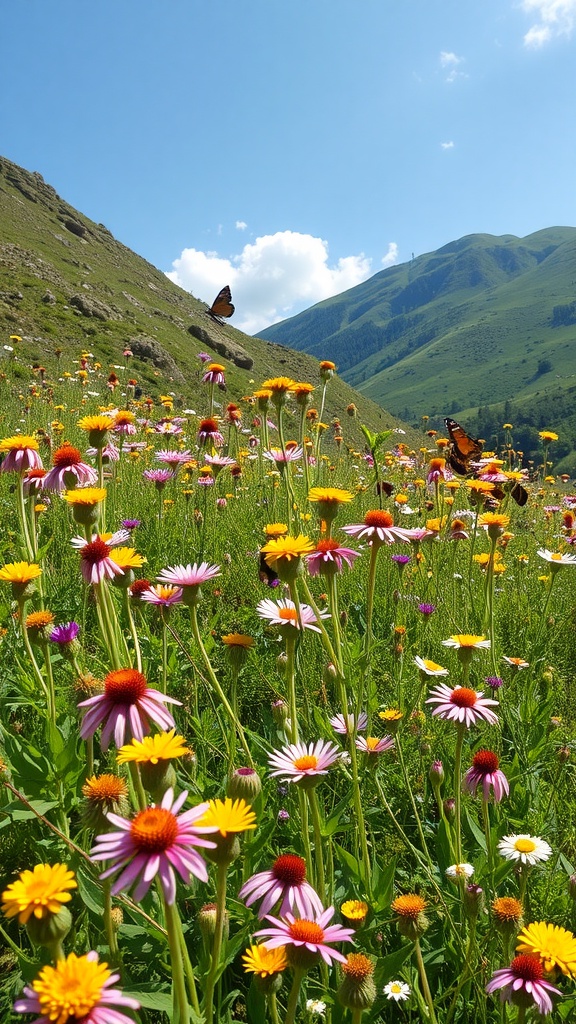
Creating a wildflower meadow on a steep hillside can add a splash of color and life to your landscape. Imagine vibrant yellows, purples, and whites dancing in the breeze. This natural beauty not only looks stunning but also supports local wildlife, like butterflies and bees.
Planting native wildflowers can be especially rewarding. They are adapted to your local climate and soil, making them easier to care for. Consider a mix of annuals and perennials to ensure blooms throughout the season. The combination of flowers will create a lively and ever-changing display.
To establish your meadow, start by clearing the area of weeds and debris. Then, scatter the wildflower seeds and lightly rake the soil to ensure they make good contact. Water the area gently to help the seeds settle in.
Maintaining your wildflower meadow is simple. Regular mowing after the flowers set seed encourages new growth and prevents weeds from taking over. Mulching can also help suppress unwanted plants while keeping moisture in the soil.
Expert Tip: For best results, plant wildflowers in the fall or early spring. This timing gives them a chance to establish roots before the heat of summer.
Shade Garden Creation
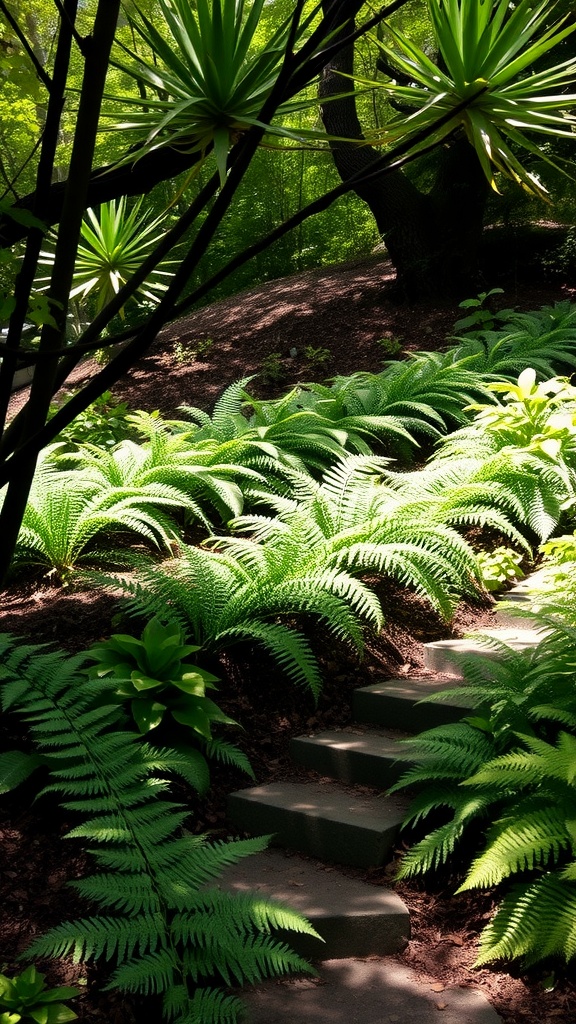
Creating a shade garden on a steep hillside can transform an underused area into a lush retreat. The image above showcases a beautiful pathway winding through vibrant foliage. This design invites you to explore and enjoy the shaded spots that can flourish in your garden.
Choose plants that thrive in low light, such as ferns and palms. These plants not only provide greenery but also add texture and depth to your space. The round stepping stones in the pathway lead you through an oasis of greenery, making it a delightful journey in your own backyard.
Consider using a mix of potted plants and ground cover to create layers. The pots can house flowering plants that add splashes of color amidst the greens. The natural stones used for the path complement the plants, providing a rustic feel.
Expert Tip: When planning your shade garden, remember to consider the moisture levels. Shade areas can retain moisture longer, so selecting drought-resistant plants can help maintain balance.
Succulent Rock Gardens
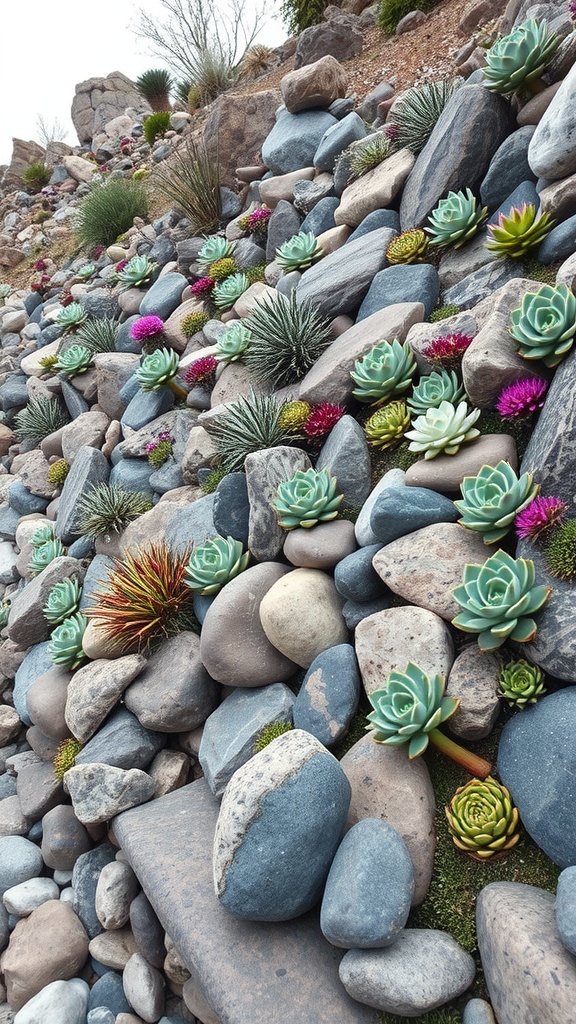
Creating a succulent rock garden is a fun and stylish way to enhance a steep hillside. This design combines natural aesthetics with low-maintenance plants, making it perfect for those who love greenery without the fuss.
In the image, you can see a beautiful arrangement of succulents nestled among various rocks. The contrasting textures of smooth stones and vibrant green plants create a visually appealing scene. Using different sizes and colors of rocks adds depth and character to the garden.
Succulents thrive in dry conditions, making them ideal for rocky landscapes. They require minimal watering, which is a huge plus for busy gardeners. Be sure to select a variety of succulents to introduce different shapes and colors.
Expert Tip: When planning your rock garden, think about drainage. Ensure the soil is well-drained to prevent water from pooling around the roots, which can lead to rot.
Cascading Flower Beds
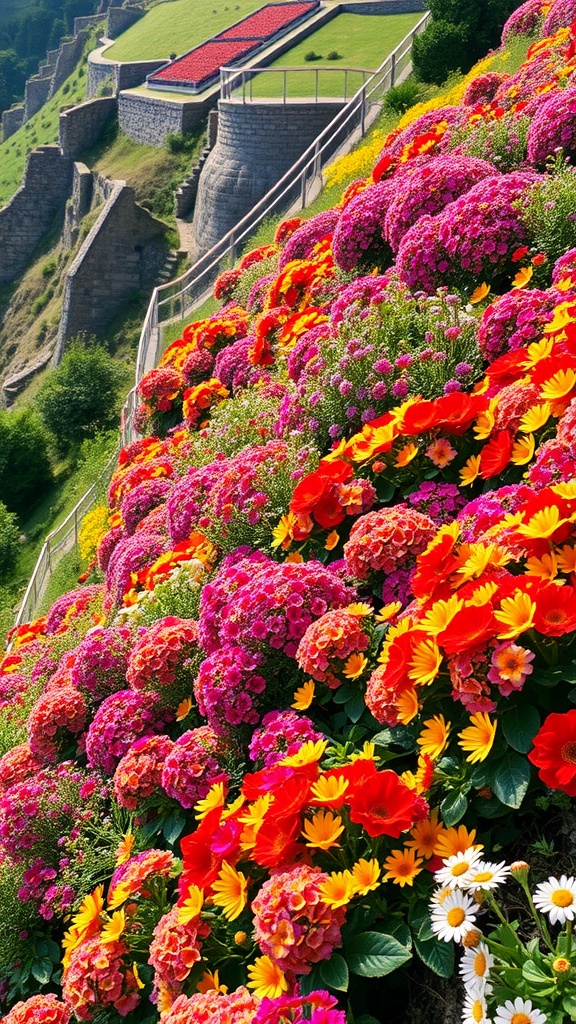
Cascading flower beds can transform any steep hillside into a stunning visual treat. Imagine vibrant blooms spilling over steps, creating a colorful waterfall effect. This not only adds beauty but also draws the eye upward, enhancing the landscape.
Using a mix of flowers, like deep red roses and delicate pink daisies, can create an eye-catching contrast. Layering different types ensures a lush, full look. Additionally, you can incorporate greenery, which adds texture and depth.
Expert Tip: Choose flowers that bloom at different times to keep your garden looking vibrant throughout the seasons.
A cascading design can also help with erosion control. By planting densely, the roots will stabilize the soil while beautifying the space. A well-planned flower bed can be as functional as it is lovely.
Slope-Friendly Ground Covers
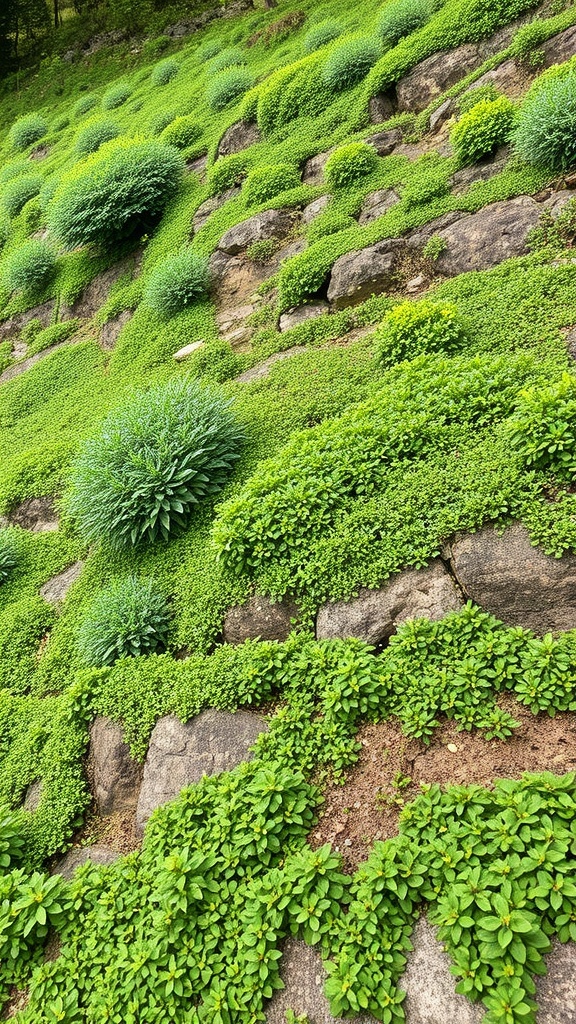
When dealing with a steep hillside, choosing the right ground covers is key. The image showcases a lush green slope, perfectly illustrating how ground cover can thrive on an incline. This greenery not only adds beauty but also helps prevent soil erosion.
Some of the best options for steep slopes include creeping phlox, sedum, and ground morning glory. These plants are hardy and can establish roots that hold the soil in place.
Using ground covers will also minimize maintenance. Once established, they require less water and care compared to traditional lawn grasses. They create a vibrant, low-maintenance landscape that enhances the natural beauty of the slope.
Incorporating Seating Areas
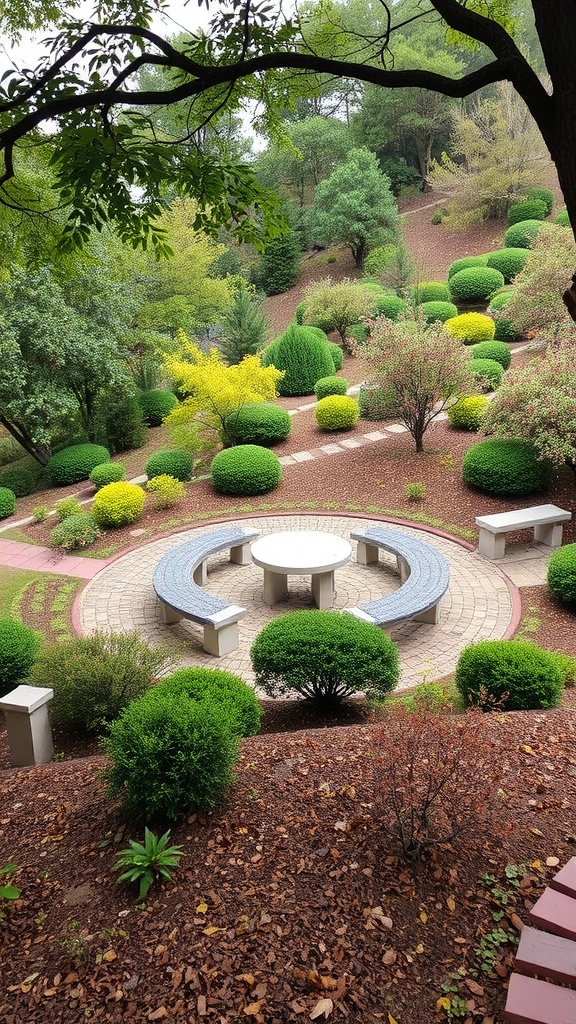
Incorporating seating areas on a steep hillside can transform a challenging slope into a cozy getaway. The image shows a lovely terrace with wooden furniture, perfect for enjoying the view. By placing seating strategically, you can create inviting spots that make the most of your garden.
Using natural materials like wood helps the seating blend into the landscape. It’s also smart to choose weather-resistant furniture, ensuring it lasts through the seasons. Add cushions for comfort, and you have a delightful nook for relaxing.
Consider multi-level seating to match the slope’s contours. This approach not only adds visual interest but also makes navigating the hillside easier. You can even incorporate built-in benches along pathways or at the top of the slope for a seamless look.
Expert Tip: To enhance the space, include potted plants or small garden features near the seating. This will create a lush environment and provide a bit of shade, making it even more inviting.
Outdoor Steps and Stairs
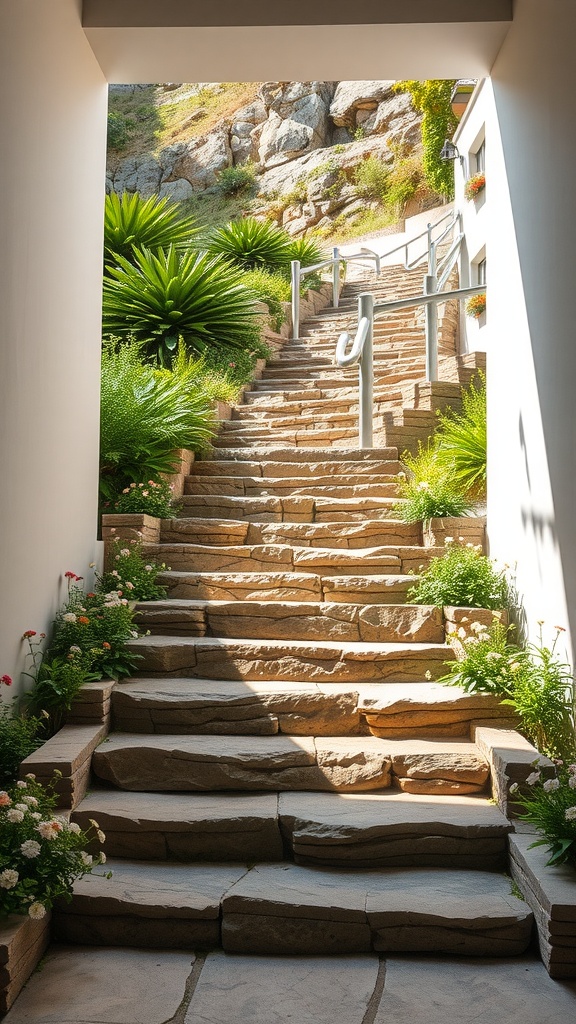
When it comes to landscaping steep hillsides, outdoor steps and stairs are a game changer. They provide not just function but also beauty. The image shows a stunning set of stone steps that gracefully ascend a hillside, surrounded by vibrant greenery and blooming flowers.
Stone steps like these create a natural flow in your landscape. They offer a safe way to navigate the incline while showcasing the beauty of the surroundings. The addition of plants along the sides softens the hard edges and makes the entire space feel inviting.
Expert Tip: Consider using native plants in your landscaping. They require less maintenance and enhance the natural beauty of the area.
Adding a railing can also improve safety while enhancing the aesthetic. The metal railings in the image blend well with the stone, providing a modern touch. Feel free to mix materials to suit your style!
Pollinator Gardens
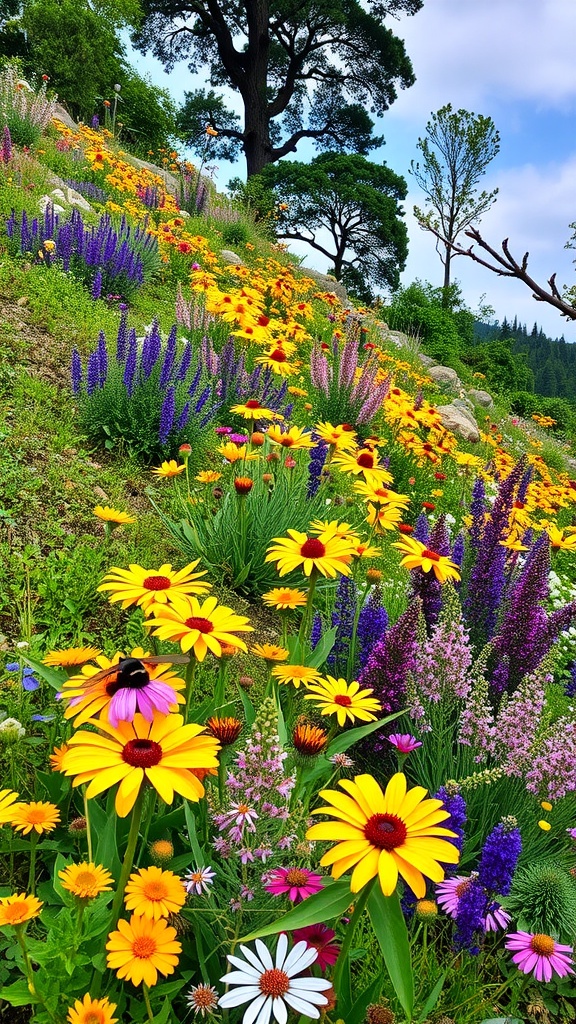
Creating a pollinator garden on a steep hillside is a fantastic way to support local wildlife and add beauty to your landscape. The image showcases a vibrant arrangement of colorful flowers, including daisies and petunias, all thriving on a slope. Bees and other pollinators are buzzing around, enjoying the nectar.
When choosing plants, consider native species that encourage pollinator activity. These plants are adapted to the local climate and soil conditions, making them easier to maintain. Organizing your flowers in clusters can provide a more welcoming environment for bees and butterflies, making it easier for them to find food.
Including a variety of flower types ensures that something is blooming throughout the seasons. This guarantees a steady food source for pollinators year-round. The bright colors and diverse shapes attract a range of species, enhancing the garden’s ecological value.
Expert Tip: Consider adding a small flag, like the American flag seen in the image, to bring a personal touch to your garden. It can also serve as a fun way to mark your space while celebrating local pride.
Rain Gardens for Drainage
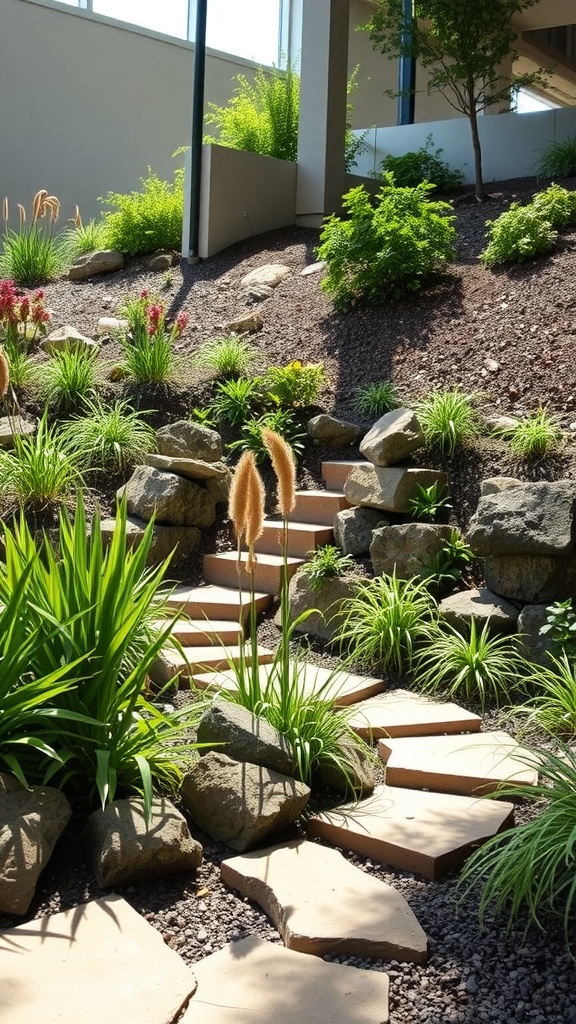
Rain gardens are a smart choice for steep hillsides, helping manage drainage while adding beauty to your landscape. They collect and soak up rainwater runoff, preventing erosion and flooding.
The image shows a well-designed rain garden featuring natural stones, lush plants, and a clear pathway. This design not only captures rainwater but also creates an inviting space in your yard.
By incorporating a variety of native plants, you create a sustainable environment. These plants are adapted to local conditions and require less water and maintenance.
Expert Tip: Choose plants that thrive in wet and dry conditions to ensure your rain garden remains healthy year-round.
Rain gardens can be both functional and attractive. They can enhance the visual appeal of a steep hillside while effectively managing water flow.
Decorative Grasses
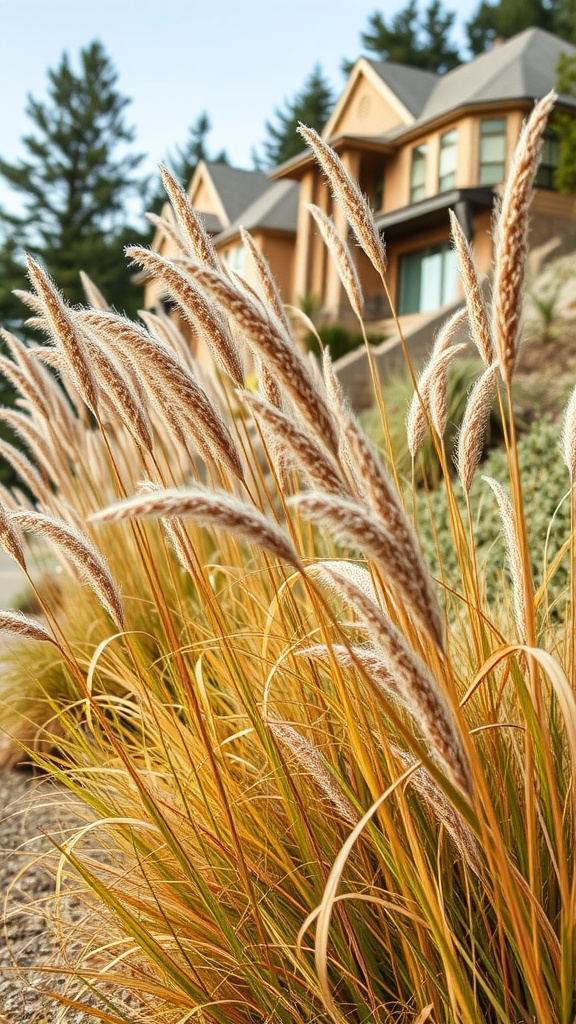
Decorative grasses are a fantastic choice for landscaping steep hillsides. They add texture and movement to your garden. The image above showcases a beautiful arrangement of grass that sways gently in the breeze. These plants can create a soft, inviting look while providing stability to the soil.
Grasses like Pampas Grass or Feather Reed Grass thrive in various conditions. They are drought-resistant, making them perfect for hillsides where water may run off easily. Their feathery plumes can catch sunlight, adding sparkle to your landscape.
Spacing is key when planting. Consider grouping grasses in clusters for a more natural appearance. This method can help prevent soil erosion while creating a layered effect that enhances visual interest.
Expert Tip: Choose native grasses for your area. They will be more resilient and require less maintenance. Plus, they can attract local wildlife, contributing to a vibrant ecosystem.
Vertical Garden Installations
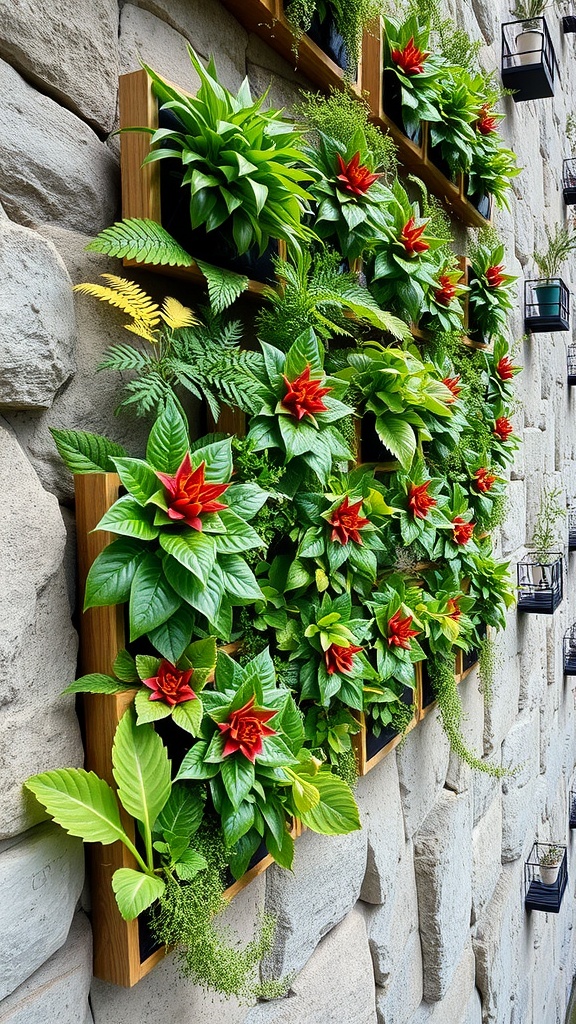
Vertical gardens are a fantastic way to add greenery to steep hillsides. They not only save space but also create a stunning visual impact. The image shows a vibrant vertical garden with a variety of plants, showcasing how lush life can thrive vertically.
This design can transform a plain wall into a lively canvas of color and texture. Incorporating different plant types, like ferns, succulents, and flowering plants, creates depth and interest. Even in a compact area, vertical gardens can offer a mini-ecosystem that enhances the landscape.
Expert Tip: Choose plants that thrive in your local climate. This ensures that your vertical garden flourishes with minimal maintenance.
Moreover, vertical gardens can help with insulation and air quality in your home. They can also attract birds and beneficial insects, making your space feel more alive.
Seasonal Color Planning
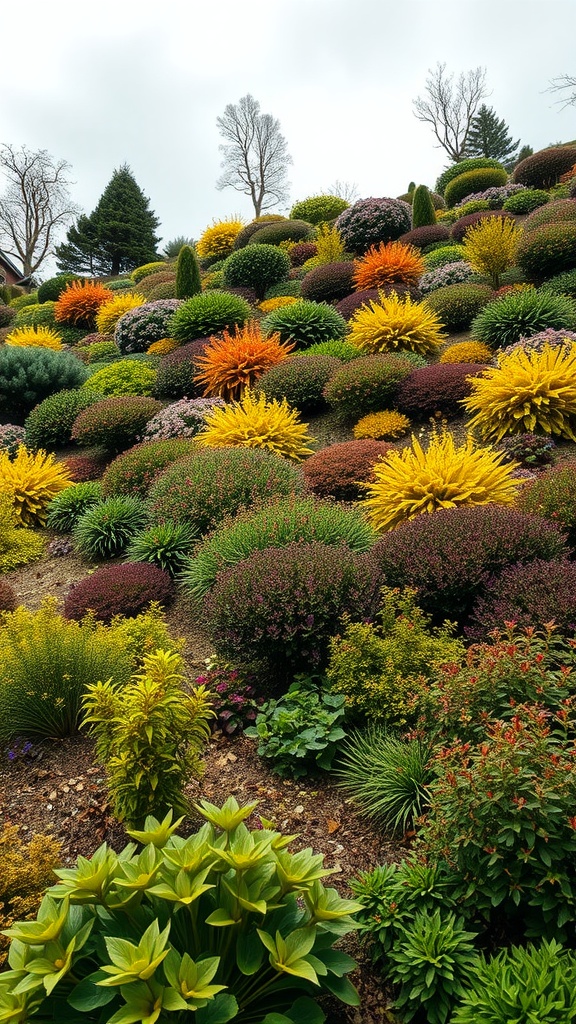
When landscaping a steep hillside, seasonal color planning is key to creating a stunning visual impact. The image showcases a vibrant array of plants that burst with color, particularly in the fall. Here, shades of yellow, orange, and deep purple blend harmoniously, making the hillside a focal point in any garden.
Choosing the right plants for each season is essential. For spring, consider adding bulbs like tulips or daffodils to introduce early color. In summer, vibrant flowers such as daylilies or coneflowers can thrive, while fall brings the rich hues seen in the image.
Don’t forget winter! Evergreens and ornamental grasses can keep your hillside interesting all year long. Mixing textures and colors not only creates a beautiful landscape but also ensures it looks good through every season.
Themed Landscaping Zones
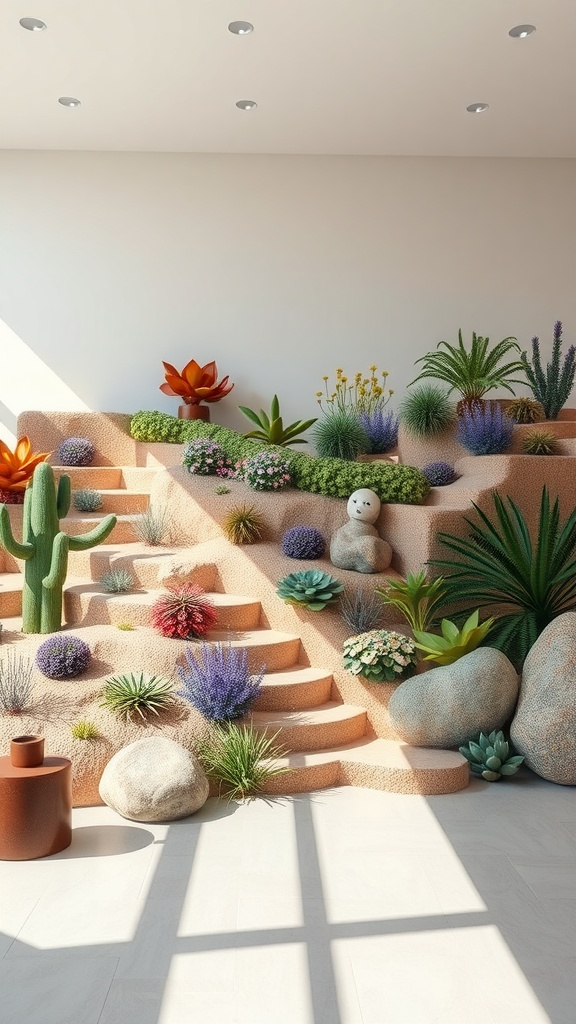
Creating themed landscaping zones on a steep hillside can add character and charm to your outdoor space.
The image showcases a beautifully arranged hillside with various plants and decorative elements that give it a unique look. The use of different colors and textures creates an inviting atmosphere.
In this design, you can see vibrant flowers, cacti, and lush greenery, all arranged in a tiered fashion. This tiering helps to manage the slope, making it visually appealing and practical.
The use of rocks and planters adds to the aesthetic, providing natural elements that enhance the overall theme.
Consider incorporating specific themes like a desert oasis or a Mediterranean garden for your hillside. You can mix succulents with tropical plants to create a lively and diverse landscape. The key is to choose plants that thrive in your local climate while maintaining a cohesive look.
Expert Tip: Use pathways or steps between the different zones for easy access and to guide visitors through your garden. This not only makes maintenance simpler but also encourages exploration of your themed areas.
Hiking Trails and Access
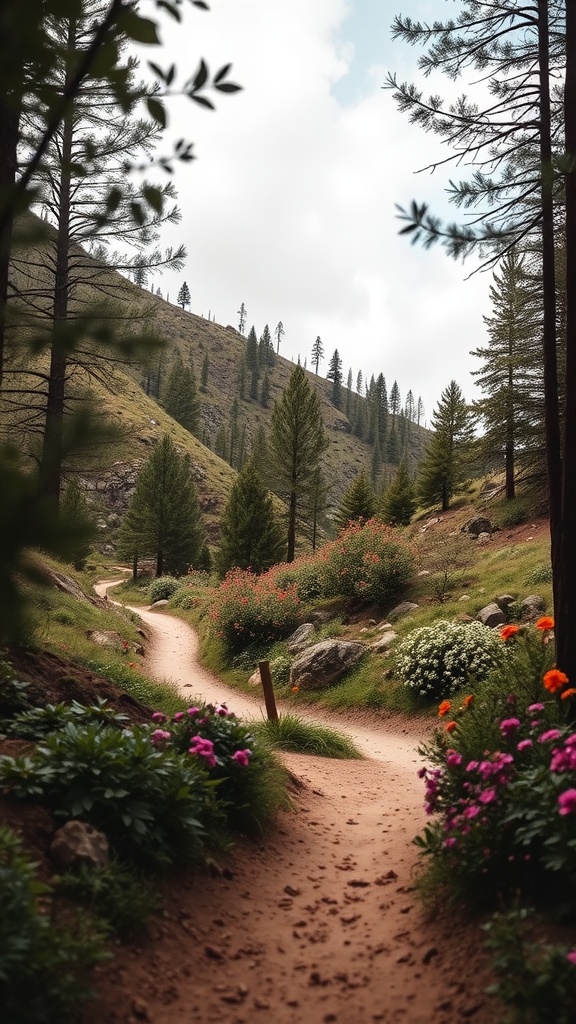
When it comes to steep hillside landscaping, creating accessible hiking trails is key. The image shows a winding path surrounded by lush greenery and blooming flowers. This not only enhances the beauty of the area but also invites people to explore.
Designing trails that curve smoothly can help minimize erosion. The gentle slopes in the image allow hikers to enjoy the scenery without excessive strain. Natural materials like wood or stone can be used to maintain the trail’s integrity.
Incorporating vibrant flowers along the trail adds a splash of color and helps attract local wildlife. It’s a simple way to make the path more inviting and enjoyable for everyone.
Expert Tip: Consider adding resting spots along the trail. Benches or viewpoints can provide a place for hikers to relax and take in the beautiful surroundings.
Fire Pit Gathering Spots
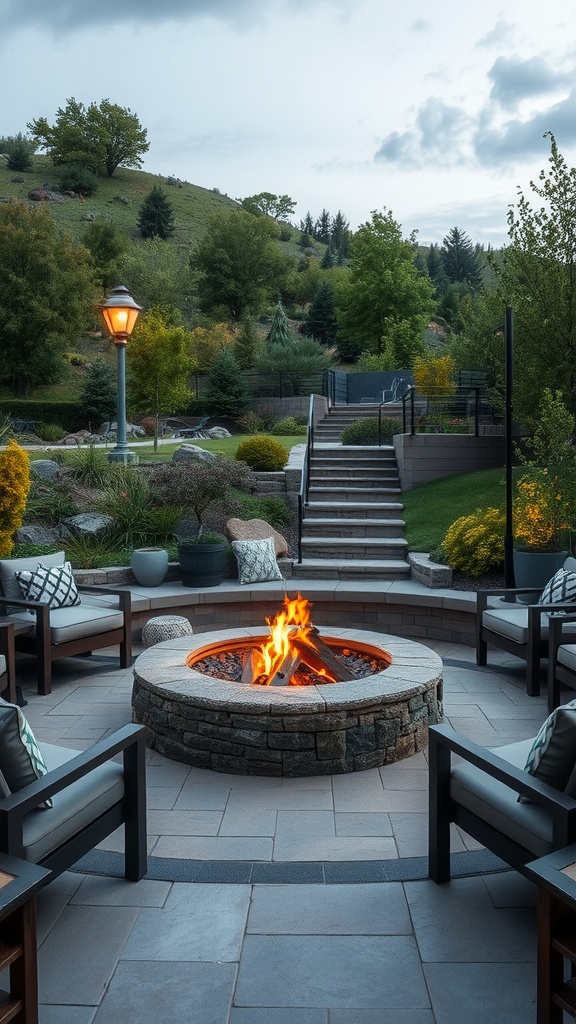
Creating a cozy fire pit area on a steep hillside can transform your outdoor space into a perfect gathering spot.
Picture a circular stone fire pit surrounded by comfortable seating. This setup invites friends and family to relax and enjoy each other’s company as they share stories around the warm glow of the flames.
The design in the image showcases a well-planned layout. The fire pit is made from natural stone, giving it a rustic feel that blends seamlessly with the surrounding landscape. Cushioned chairs surround the pit, providing comfort for long evenings spent outside.
Stairs lead up to other areas of the yard, making the space functional and easy to navigate. The greenery around adds a touch of nature, enhancing the outdoor experience. Plus, the gentle hillside creates a natural backdrop that feels both inviting and serene.
Sustainable Practices in Landscaping
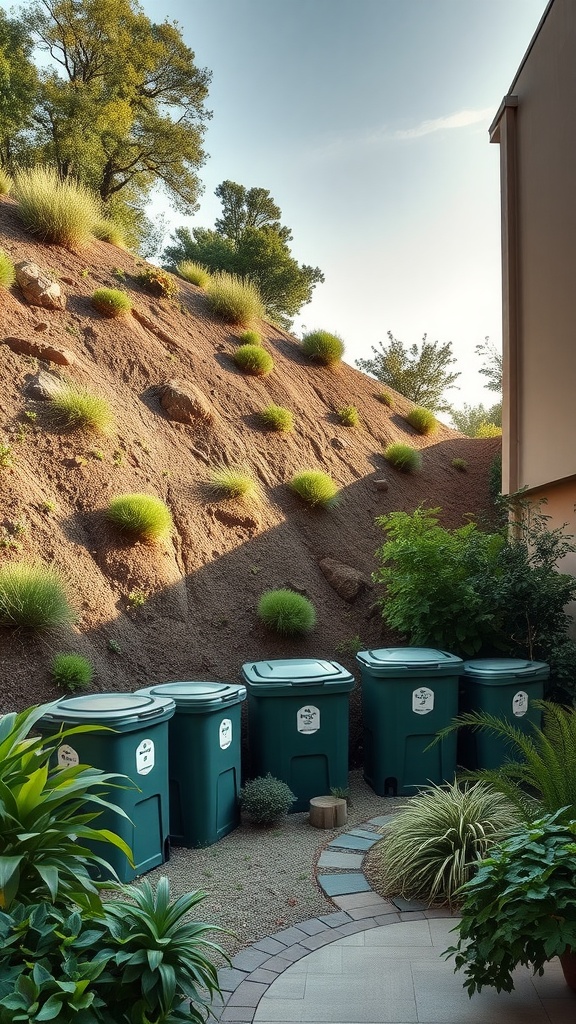
When dealing with steep hillsides, sustainability is key. The image showcases a hillside that is thoughtfully landscaped with native plants. These plants are not just pretty; they help prevent erosion and provide habitat for local wildlife.
The use of native species is crucial. They require less water, which is great for conserving resources. Here, you can see how the green grasses and shrubs blend perfectly with the natural terrain, creating a harmonious look.
Another standout feature in the image is the strategic placement of bins for waste collection. This not only maintains cleanliness but also promotes recycling. It shows how practical solutions can blend with landscaping.
Expert Tip: Consider using mulch or stone for pathways. This helps with drainage and adds texture to the landscape.
Incorporating these sustainable practices into your hillside can lead to a thriving ecosystem right in your backyard. The end result is beautiful and environmentally friendly.
Artistic Sculptures and Installations
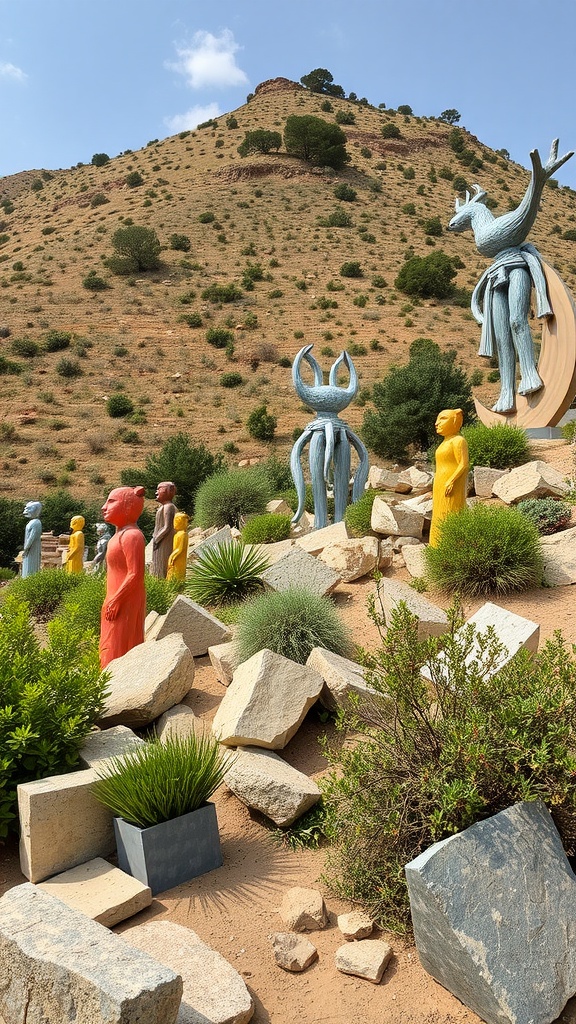
When it comes to steep hillside landscaping, artistic sculptures can make a significant impact. This image showcases three unique sculptures that blend beautifully with the natural surroundings. They capture attention and invite viewers to explore the space.
The first sculpture has a smooth, flowing shape, while the second appears to twist and turn in a playful manner. The third sculpture offers an intricate design that draws the eye. These pieces not only add visual interest but also enhance the overall atmosphere of the hillside.
These sculptures are strategically placed among lush grasses, creating a contrast that highlights their forms. This combination can inspire you to think about how art can coexist with nature in your own landscaping.
Expert Tip: When selecting sculptures for your garden, consider the scale and materials. Choose pieces that resonate with the environment and complement the plants around them.
